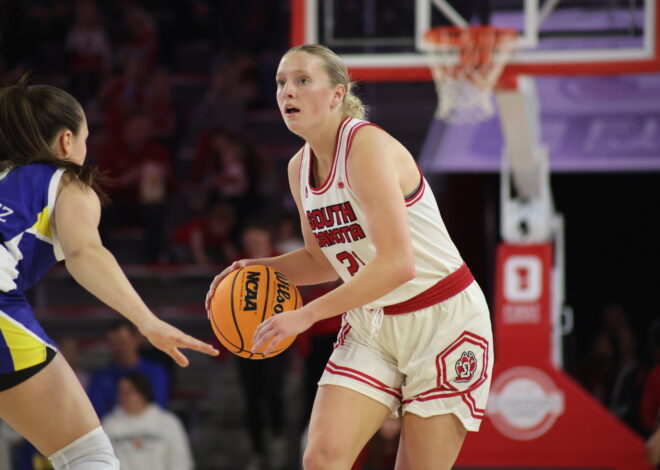Trio finds niche in ‘Yote rotation
With only two seniors on the roster, the University of South Dakota men’s basketball team began the 2012-13 season short on veteran experience.
As a result, three first-year players have gained valuable playing time for the Coyotes over the course of the season: Casey Kasperbauer, Eric Robertson and Tyler Flack. Through 26 games, the trio has played a combined 42 minutes per game.
While only Kasperbauer has emerged with consistent minutes as a starter, each first-year has found his own niche in the rotation. As a combo guard, Kasperbauer has been featured mostly as a primary scoring option for the Coyotes.
“The coaches want me to be the guy to shoot the ball consistently,” Kasperbauer said. “By doing that, we open up the defense a lot; it opens up lanes for our point guard to drive and create out of that. It also gets Trevor (Gruis) his post feeds and do his thing down low.”
Averaging 26.1 minutes per game, Kasperbauer has averaged 8.6 points and 1.8 assists thus far. The Carroll, Iowa native is shooting 44.9 percent from the field and 42.9 percent from downtown.
Robertson described Kasperbauer as one of the fiercest competitors on the basketball floor.
“When he’s on the court, he’s got a ratchet (great jump-shot) and is just determined to kill whoever is guarding him,” Robertson said.
While Kasperbauer and several other USD perimeter players generate much of USD’s offense from outside, Flack and Robertson are featured in the interior as either the four or five. Neither post player has averaged as many minutes as Kasperbauer but each provides a specific skill coming off the bench.
At 6’7” and 205 pounds, Flack said he primarily acts as a disruptive force on the defensive end and scores mostly through offensive putbacks, though he is also capable of hitting the occasional open jump shot.
“I mainly contribute with rebounding, defense and blocking shots. I’d say my mid-range game has been doing well to where I can step outside and shoot,” Flack said.
Despite coming off the bench in most games, Flack has been effective while on the floor. In 19.2 minutes per game, he has averaged five points, four rebounds and 1.4 blocks per game while shooting 43.8 percent from the field.
While Flack operates as a physically dominating presence in the post, Robertson said he provides USD with a change of pace on the inside. While Gruis is featured as a traditional post-up center and Flack provides energy and hustle plays on both ends, the Wayzata, Minn. native said he spreads the floor as a shooter.
“I do a lot of on-ball screens and pick-and-pops,” Roberson said. “I’m still trying to figure things out defensively, and I’ve got to gain weight, but that will come. Right now, I’m kind of all over the place, playing the three, four or the five. It just depends.”
Kasperbauer said Robertson’s pick-and-pop game provides USD’s offense with a unique wrinkle.
“When he picks and pops, that brings a big defender away from the basket, and if it doesn’t open up Eric’s shot, he can open up one of our big guy’s shots. It really spreads out the defense,” Kasperbauer said.
Though the two rarely share the floor together, Flack said he and Robertson have developed a unique two-man game in the post, aided by their chemistry as first-year players.
“We’re always screening for each other, always looking to pass it to each other and get each other shots,” Flack said.
However, while the current season has not come to a close and the Coyotes still have to play in the Summit League tournament, Kasperbauer said the group is looking forward to the off-season.
“There’s a saying that college basketball players get the best improvement from their freshman year to their sophomore year because they know what needs to be done,” Kasperbauer said. “I think this offseason we’re going to have a different mind set than we did last year. Last year, we were new and thrown into the mix and we kind of just went with the flow.
While each player identified individual areas they will each work on during the upcoming summer, Kasperbauer noted Flack’s physical attributes give him the highest ceiling for development.
“He’s our most athletic guy,” he said. “Even as far back as the summer, we’d talk about how much potential he has just because of his athleticism. He has raw talent right now, and while all of us can improve, I see the most improvement coming from him.”
In addition to their on-court chemistry, the three first-year players said they have bonded as friends and teammates away from basketball.
“We love hanging out with each other,” Robertson said. “We’re roommates, and we are all really close.”
Despite his on-court intensity, Robertson described Kasperbauer as happy-go-lucky off the court.
“The kid is all over the place and I personally love it,” Robertson said. “He always has a great attitude; he’s one of the nicest kids you could meet off-the court. He’s always smiling and doing pretty weird things. He’s just a goofy kid.”
Kasperbauer said all three first-years have unique personalities and enjoy a distinct sense of humor. He cited a recent YouTube video featuring USD basketball and dance team members dancing to the Internet sensation “Harlem Shake” as an example of the trio’s unique humor.
“If anyone wants to see just how goofy we actually are, watch our video of the Harlem Shake we did with the dance team,” he said.
As regular season play wraps up and the Coyotes head into the Summit League, Kasperbauer, Flack and Robertson will play their final games as first-years and head into the off season hungry for
improvement.

